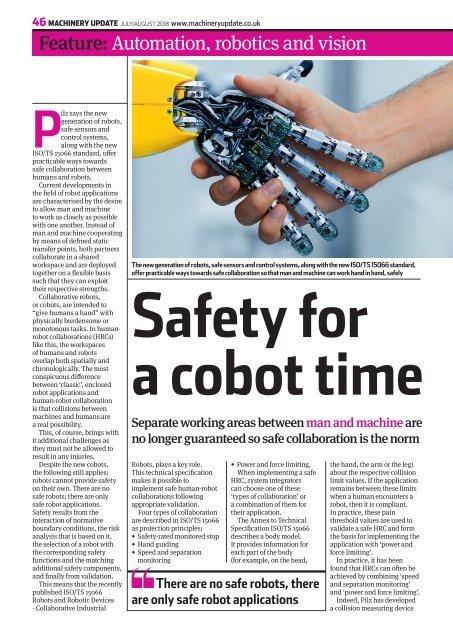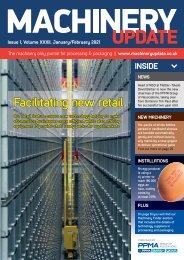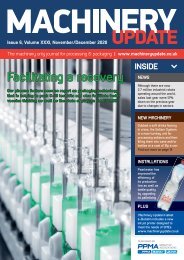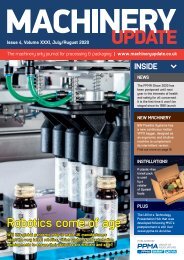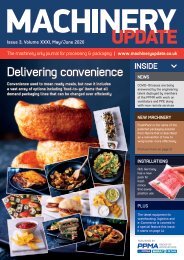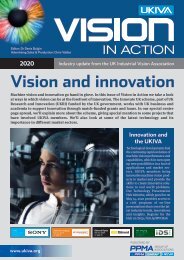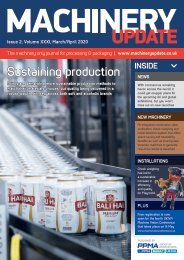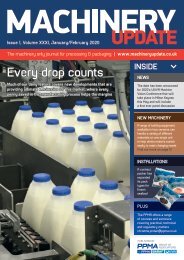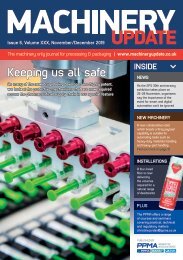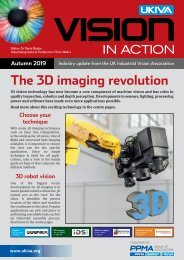July August hi-res with ads
You also want an ePaper? Increase the reach of your titles
YUMPU automatically turns print PDFs into web optimized ePapers that Google loves.
46 MACHINERY UPDATE JULY/AUGUST 2018 www.mac<strong>hi</strong>neryupdate.co.uk<br />
Feature: Automation, robotics and vision<br />
Pilz says the new<br />
generation of robots,<br />
safe sensors and<br />
control systems,<br />
along <strong>with</strong> the new<br />
ISO/TS 15066 standard, offer<br />
practicable ways towards<br />
safe collaboration between<br />
humans and robots.<br />
Current developments in<br />
the field of robot applications<br />
are characterised by the desire<br />
to allow man and mac<strong>hi</strong>ne<br />
to work as closely as possible<br />
<strong>with</strong> one another. Instead of<br />
man and mac<strong>hi</strong>ne cooperating<br />
by means of defined static<br />
transfer points, both partners<br />
collaborate in a shared<br />
workspace and are deployed<br />
together on a flexible basis<br />
such that they can exploit<br />
their <strong>res</strong>pective strengths.<br />
Collaborative robots,<br />
or cobots, are intended to<br />
“give humans a hand” <strong>with</strong><br />
physically burdensome or<br />
monotonous tasks. In humanrobot<br />
collaborations (HRCs)<br />
like t<strong>hi</strong>s, the workspaces<br />
of humans and robots<br />
overlap both spatially and<br />
chronologically. The most<br />
conspicuous difference<br />
between ‘classic’, enclosed<br />
robot applications and<br />
human-robot collaboration<br />
is that collisions between<br />
mac<strong>hi</strong>nes and humans are<br />
a real possibility.<br />
T<strong>hi</strong>s, of course, brings <strong>with</strong><br />
it additional challenges as<br />
they must not be allowed to<br />
<strong>res</strong>ult in any injuries.<br />
Despite the new cobots,<br />
the following still applies:<br />
robots cannot provide safety<br />
on their own. There are no<br />
safe robots; there are only<br />
safe robot applications.<br />
Safety <strong>res</strong>ults from the<br />
interaction of normative<br />
boundary conditions, the risk<br />
analysis that is based on it,<br />
the selection of a robot <strong>with</strong><br />
the cor<strong>res</strong>ponding safety<br />
functions and the matc<strong>hi</strong>ng<br />
additional safety components,<br />
and finally from validation.<br />
T<strong>hi</strong>s means that the recently<br />
published ISO/TS 15066<br />
Robots and Robotic Devices<br />
- Collaborative Industrial<br />
The new generation of robots, safe sensors and control systems, along <strong>with</strong> the new ISO/TS 15066 standard,<br />
offer practicable ways towards safe collaboration so that man and mac<strong>hi</strong>ne can work hand in hand, safely<br />
Safety for<br />
a cobot time<br />
Separate working areas between man and mac<strong>hi</strong>ne are<br />
no longer guaranteed so safe collaboration is the norm<br />
Robots, plays a key role.<br />
T<strong>hi</strong>s technical specification<br />
makes it possible to<br />
implement safe human-robot<br />
collaborations following<br />
appropriate validation.<br />
Four types of collaboration<br />
are described in ISO/TS 15066<br />
as protection principles:<br />
• Safety-rated monitored stop<br />
• Hand guiding<br />
• Speed and separation<br />
monitoring<br />
• Power and force limiting.<br />
When implementing a safe<br />
HRC, system integrators<br />
can choose one of these<br />
‘types of collaboration’ or<br />
a combination of them for<br />
their application.<br />
The Annex to Technical<br />
Specification ISO/TS 15066<br />
describes a body model.<br />
It provides information for<br />
each part of the body<br />
(for example, on the head,<br />
There are no safe robots, there<br />
are only safe robot applications<br />
the hand, the arm or the leg)<br />
about the <strong>res</strong>pective collision<br />
limit values. If the application<br />
remains between these limits<br />
when a human encounters a<br />
robot, then it is compliant.<br />
In practice, these pain<br />
th<strong>res</strong>hold values are used to<br />
validate a safe HRC and form<br />
the basis for implementing the<br />
application <strong>with</strong> ‘power and<br />
force limiting’.<br />
In practice, it has been<br />
found that HRCs can often be<br />
ac<strong>hi</strong>eved by combining ‘speed<br />
and separation monitoring’<br />
and ‘power and force limiting’.<br />
Indeed, Pilz has developed<br />
a collision measuring device


